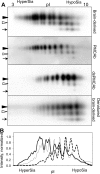Sialylation Controls Prion Fate in Vivo
- PMID: 27998976
- PMCID: PMC5313106
- DOI: 10.1074/jbc.M116.768010
Sialylation Controls Prion Fate in Vivo
Abstract
Prions or PrPSc are proteinaceous infectious agents that consist of misfolded, self-replicating states of a sialoglycoprotein called the prion protein or PrPC The current work tests a new hypothesis that sialylation determines the fate of prions in an organism. To begin, we produced control PrPSc from PrPC using protein misfolding cyclic amplification with beads (PMCAb), and also generated PrPSc with reduced sialylation levels using the same method but with partially desialylated PrPC as a substrate (dsPMCAb). Syrian hamsters were inoculated intraperitoneally with brain-derived PrPSc or PrPSc produced in PMCAb or dsPMCAb and then monitored for disease. Animals inoculated with brain- or PMCAb-derived PrPSc developed prion disease, whereas administration of dsPMCAb-derived PrPSc with reduced sialylation did not cause prion disease. Animals inoculated with dsPMCAb-derived material were not subclinical carriers of scrapie, as no PrPSc was detected in brains or spleen of these animals by either Western blotting or after amplification by serial PMCAb. In subsequent experiments, trafficking of brain-, PMCAb-, and dsPMCAb-derived PrPSc to secondary lymphoid organs was monitored in wild type mice. PrPSc sialylation was found to be critical for effective trafficking of PrPSc to secondary lymphoid organs. By 6 hours after inoculation, brain- and PMCAb-derived PrPSc were found in spleen and lymph nodes, whereas dsPMCAb-derived PrPSc was found predominantly in liver. This study demonstrates that the outcome of prion transmission to a wild type host is determined by the sialylation status of the inoculated PrPSc Furthermore, this work suggests that the sialylation status of PrPSc plays an important role in prion lymphotropism.
Keywords: Fourier transform IR (FTIR); N-linked glycans; N-linked glycosylation; cyclic amplification; prion; prion disease; protein misfolding; secondary lymphoid organs; sialic acid; sialylation; spleen.
© 2017 by The American Society for Biochemistry and Molecular Biology, Inc.
Conflict of interest statement
The authors declare that they have no conflicts of interest with the contents of this article
Figures




Similar articles
-
Sialylation of prion protein controls the rate of prion amplification, the cross-species barrier, the ratio of PrPSc glycoform and prion infectivity.PLoS Pathog. 2014 Sep 11;10(9):e1004366. doi: 10.1371/journal.ppat.1004366. eCollection 2014 Sep. PLoS Pathog. 2014. PMID: 25211026 Free PMC article.
-
Reversible off and on switching of prion infectivity via removing and reinstalling prion sialylation.Sci Rep. 2016 Sep 9;6:33119. doi: 10.1038/srep33119. Sci Rep. 2016. PMID: 27609323 Free PMC article.
-
Sialylation of the prion protein glycans controls prion replication rate and glycoform ratio.Sci Rep. 2015 Nov 18;5:16912. doi: 10.1038/srep16912. Sci Rep. 2015. PMID: 26576925 Free PMC article.
-
Role of sialylation in prion disease pathogenesis and prion structure.Prog Mol Biol Transl Sci. 2020;175:31-52. doi: 10.1016/bs.pmbts.2020.07.004. Epub 2020 Aug 24. Prog Mol Biol Transl Sci. 2020. PMID: 32958238 Review.
-
Role of sialylation of N-linked glycans in prion pathogenesis.Cell Tissue Res. 2023 Apr;392(1):201-214. doi: 10.1007/s00441-022-03584-2. Epub 2022 Jan 28. Cell Tissue Res. 2023. PMID: 35088180 Free PMC article. Review.
Cited by
-
Production of Artificially Doubly Glycosylated, 15N Labeled Prion Protein for NMR Studies Using a pH-Scanning Volatile Buffer System.J Org Chem. 2020 Feb 7;85(3):1687-1690. doi: 10.1021/acs.joc.9b02430. Epub 2019 Nov 20. J Org Chem. 2020. PMID: 31692356 Free PMC article.
-
Full restoration of specific infectivity and strain properties from pure mammalian prion protein.PLoS Pathog. 2019 Mar 25;15(3):e1007662. doi: 10.1371/journal.ppat.1007662. eCollection 2019 Mar. PLoS Pathog. 2019. PMID: 30908557 Free PMC article.
-
From Posttranslational Modifications to Disease Phenotype: A Substrate Selection Hypothesis in Neurodegenerative Diseases.Int J Mol Sci. 2021 Jan 18;22(2):901. doi: 10.3390/ijms22020901. Int J Mol Sci. 2021. PMID: 33477465 Free PMC article. Review.
-
Analysis of Covalent Modifications of Amyloidogenic Proteins Using Two-Dimensional Electrophoresis: Prion Protein and Its Sialylation.Methods Mol Biol. 2018;1779:241-255. doi: 10.1007/978-1-4939-7816-8_15. Methods Mol Biol. 2018. PMID: 29886537 Free PMC article.
-
Prion Strain-Specific Structure and Pathology: A View from the Perspective of Glycobiology.Viruses. 2018 Dec 18;10(12):723. doi: 10.3390/v10120723. Viruses. 2018. PMID: 30567302 Free PMC article. Review.
References
-
- Prusiner S. B. (1982) Novel proteinaceous infectious particles cause scrapie. Science 216, 136–144 - PubMed
-
- Legname G., Baskakov I. V., Nguyen H. O. B., Riesner D., Cohen F. E., DeArmond S. J., and Prusiner S. B. (2004) Synthetic mammalian prions. Science 305, 673–676 - PubMed
-
- Cohen F. E., and Prusiner S. B. (1998) Pathologic conformations of prion proteins. Annu. Rev. Biochem. 67, 793–819 - PubMed
-
- Baskakov I. V., and Breydo L. (2007) Converting the prion protein: what makes the protein infectious. Biochim. Biophys. Acta 1772, 692–703 - PubMed
Publication types
MeSH terms
Substances
Grants and funding
LinkOut - more resources
Full Text Sources
Other Literature Sources
Research Materials

